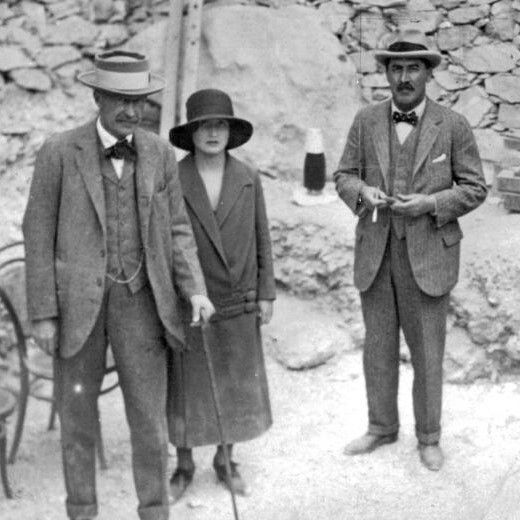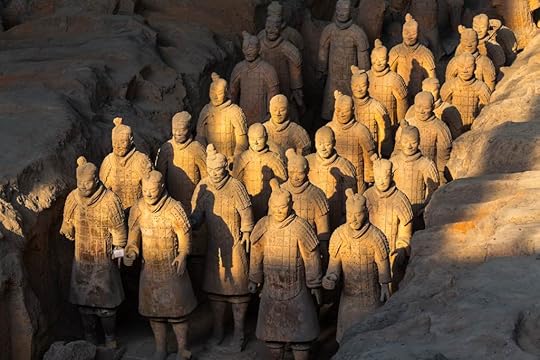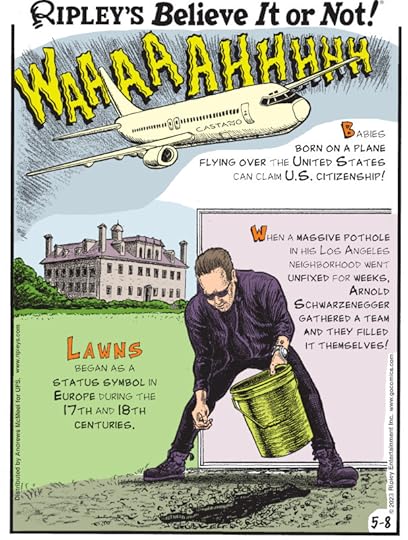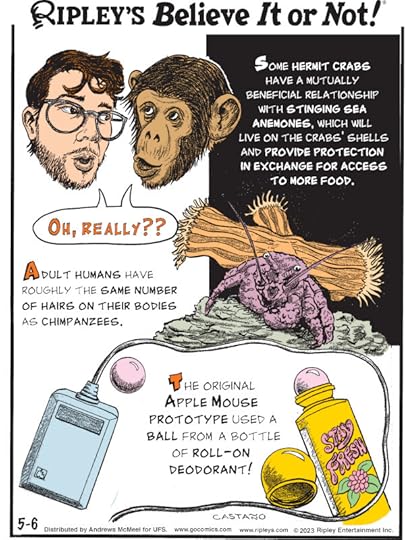Ripley Entertainment Inc.'s Blog, page 28
May 10, 2023
The Real Life Mummy’s Curse: Ancient Remains Could Infect Humans
Featured in Ripley's Believe It or Not!

The chilling lore of mummy curses continues to captivate archaeologists, treasure hunters, and history enthusiasts alike — but is there any possible logical explanation behind the legend? Travel with us back in time as we venture “behind the veil” to try to expose the real curse of the pharaohs.
While mummy curses aren’t new, it wasn’t until the discovery and opening of the tomb of Tutankhamen in the early 1900s that their popularity exploded.
It was 1922 when British archaeologist and Egyptologist Howard Carter stumbled upon the best-preserved and most important Egyptian tomb ever found. Carter had been working with Lord Carnarvon, the sponsor of the expedition, for many years, though Carnarvon was growing somewhat impatient at the amount of money spent in excavation efforts without any results.
Then in November 1922, everything changed. Carter reached the sealed doorways into what would later prove to be Tutankhamen’s tomb — and from the beginning, the discovery did seem to be cursed.
On the day the tomb was opened, Carter’s beloved canary was eaten by a cobra (which happened to be the symbol Pharaohs wore on their forehead). Then Lord Carnarvon was bitten by a mosquito, which became infected and resulted in blood poisoning and pneumonia. He died four months after stepping into the tomb.

Howard Carter, Lord Carnarvon and his daughter Lady Evelyn Herbert at the steps to the tomb of Tutankhamen. Via Wikimedia Commons.
While Carter (who was the first to look into the tomb through an opening in the wall) didn’t die until 1939, other people connected to the discovery died under mysterious circumstances over the few years following the opening of the tomb. These included the person who performed the X-ray on the mummy in 1924 and a member of Carter’s team in 1928. Other mysterious deaths followed over the years, inspiring the belief that supernatural forces were behind the happenings.
Scientists might now have an answer to the curseScientists now believe it’s possible the first person to die after opening the tomb, Lord Carnarvon, succumbed to a more “scientific form” of the dreaded mummy curse.
Rather than supernatural forces, research over the past couple of decades seems to suggest toxic pathogens living in the sealed tomb could have been to blame.
Recent studies have provided additional evidence to support this theory. For example, a 2013 study led by a team of scientists from Harvard University and the Getty Conservation Institute analyzed brown spots found on the walls of Tutankhamen’s tomb and found them to be pore-forming bacteria — meaning, the kind you could breath in and would make you very sick.
Scientists could not determine if the particularly toxic fungus Aspergillus niger was present in the tomb, and the bodies of those who died in the 1920s are long gone and not available for autopsies — but the possibility that the fungus was present and responsible for some of the deaths at the time is now a very credible hypothesis.
So could an ancient fungal infection really be to blame for the death of those involved in the 1922 excavation?
There’s a LOT of stuff waiting to kill you inside a mummy’s tombArchaeological dig sites are often perfect breeding grounds for nasty biological surprises. When a tomb has been closed for 5,000 years, there’s potential for microbial organisms, different types of fungi, traces of disease, and many other unpleasant things to continue growing. Then when a team of archaeologists arrives and opens the door, all the organic deposits that have been “sleeping” for thousands of years suddenly wake up and infect humans — or at least that’s a possibility, according to experts.
The biggest danger lurking in ancient tombs? Recent laboratory studies show it’s fungi and mold, especially the very dangerous Aspergillus niger and Aspergillus flavus. While these usually just cause allergic reactions, in people with weakened immune systems it can lead to bleeding in the lungs. According to Mayo Clinic, some people may develop something known as invasive aspergillosis after exposure, where the infection spreads to different organs, the heart, or the brain. Left untreated, this infection can be fatal.

Aspergillus niger сonidium under microscope. Credit: Alexander Klepnev Via Wikimedia Commons (CC BY-SA 4.0).
Scientists have also detected a myriad of other scary toxins inside ancient tombs. These include bacteria like Pseudomonas and Staphylococcus (which can cause everything from pneumonia to shock), ammonia gas, and formaldehyde. Scientists have also found hydrogen sulfide inside tombs, a compound that the Centers for Disease Control and Prevention (CDC) describes as potentially causing apnea, coma, and convulsions. In very extreme cases, any or a combination of these toxins can result in death.
Another theory that has become popular over the past twenty years is that Lord Carnavon might have died from histoplasmosis, an infection caused by a fungus found in bat droppings.
A study conducted in 2002 pointed out that Lord Carnavon and many of the scientists working in Tutankhamen’s tomb were likely exposed to this fungus. There’s record of a large colony of bats living in the tomb in 1922 and, according to scientists connected to the study, it’s very possible anybody walking into the tomb could have inhaled spores of the fungus mixed in with the desert dust.
This could have caused “histoplasmosis with fever, enlarged glands and pneumonia which may lead to death.” And these just happened to be the same symptoms Lord Carnavon experienced before dying.
And Tutankhamen wasn’t the only oneWhile the “King Tut curse” might be the best known, the curse seems to extend beyond ancient Egyptian pharaohs.
In 1973, a group of 12 scientists opened the tomb of 15th-century King Casimir IV Jagiellon in Poland. Casimir was a beloved and progressive king until his death in 1492, after which he was draped in silk, covered with calcium salt, and laid to rest in a sealed wooden coffin. It wasn’t a restful sleep by any means – his coffin was moved here and there and here again – over the centuries. But his coffin remained nonetheless sealed until archaeologists got to it in 1970.

King Casimir IV Jagiellon. Credit: Marcello Bacciarelli Via Wikimedia Commons (CC BY-SA 4.0).
And then, over the following few weeks, 10 of the 12 scientists involved were dead.
The culprit? Despite rumors of a “Jagiellonian curse,” turns out the killer here was a combination of 13 different types of fungi, including the deadly Aspergillus flavus fungus, which had infested the coffin and the remains of the king.
Some mummies in Mexico could be the next ones to continue the “curse”In April 2023, a group of experts from Mexico’s National Institute of Anthropology and History expressed public concern about The Mummies of Guanajuato, a group of six mummies in glass cases that appear to be covered in fungi.
These aren’t your average mummies, though – there’s no ancient curse brought on by disturbing a king’s resting place. These Mexican mummies are actually 19th or 20th-century corpses that were unintentionally mummified when their bodies were deposited in air-tight crypts. Once removed from that environment, the bodies –which still retain some of their hair and skin– almost immediately started to deteriorate and fungi soon took over.
The main problem, according to experts, is that the glass cases they’re being held in aren’t air-tight, and it’s likely fungi spores are sipping out and possibly already infecting humans.
Don’t be too disappointed about the curse being explained away — turns out mold spores can be just as terrifying!
By Diana Bocco, contributor for Ripleys.com
EXPLORE THE ODD IN PERSON! Discover hundreds of strange and unusual artifacts and get hands-on with unbelievable interactives when you visit a Ripley’s Odditorium!Source: The Real Life Mummy’s Curse: Ancient Remains Could Infect Humans
CARTOON 05-10-2023
May 9, 2023
Forget Red And Blue Pills, Would You Take The Brown Pill?
Featured in Ripley's Believe It or Not!

Weird, experimental treatments populate the annals of medical history. Some were painful and others downright bizarre. Once upon a time, ketchup was a medicine. And in 19th-century Louisiana, doctors prescribed cockroach tea (yes, it’s as bad as it sounds!) to cure tetanus. Step back in time a few more centuries to the Middle Ages, and Europeans drank alleged curatives made from distilled human skulls.
Over the millennia, creative physicians have clearly thought outside the box, and we’d wager even a “spoonful of sugar” wouldn’t help some of their medicinal results go down. But if you assume that unappetizing cures are a thing of the past, think again. Believe It Or Not!, the Food and Drug Administration (FDA) recently approved the first-ever pill made from human feces, Vowt.
The poop pill might give some patients pause, but it’s more convenient and comfortable than the alternative, an enema. Keep reading about this innovative new take on “fecal microbiota transplants” and how it could save lives.
A Nasty Cure for an Insidious InfectionConsuming another person’s poop, even in pill form, is pretty hard to stomach. But, treatment options can be few and far between for patients fighting Clostridioides difficile (or C. diff for short). And they aren’t especially pleasant. You see, C. diff is a bacteria that can wreak havoc on the digestive system.
These bacteria often proliferate out of control in the intestines of patients who’ve taken antibiotics, throwing their healthy gut microbe ratios out of whack. Too much C. diff in the intestines leads to abdominal pain, diarrhea, fever, and inflammation of the colon or colitis. But the damage doesn’t always stop there.

A medical illustration of Clostridioides difficile bacteria. Credit: Jennifer Oosthuizen Via Wikimedia Commons.
It can lead to organ failure and even death. What’s the official fatality tally on this insidious bacterium? Anywhere from 15,000 to 30,000 deaths annually. Moreover, one in every six patients struggling with C. diff will see a resurgence of the nasty organism within the first two months of recovery.
The result is a vicious cycle that can destroy a patient’s health and even take their life. What makes treating it so problematic? Traditionally, doctors prescribed more antibiotics, which damaged even more of a patient’s human gut bacteria. This, in turn, made more room for C. diff to go wild.
Poop Pills for Patients Show PotentialDoctors grasped at straws for alternative means of healing their patients’ digestive systems. Some pioneering physicians soon began experimenting with “fecal microbiota transplants.” By injecting fecal matter from healthy individuals into the colons of individuals infected with C. diff, they hoped to establish a healthier gut balance.
Until recently, such treatments proved experimental and expensive because insurance didn’t cover them. Ask patients, and they might add inconvenient, uncomfortable, and invasive to the list of cons, too. That’s where Vowst comes into play. For patients who can get their heads past placing a human poop pill in their mouth and swallowing it, the results can be impressive.
As the FDA’s Dr. Peter Marks explains, “The availability of a fecal microbiota product that can be taken orally is a significant step forward in advancing patient care and accessibility for individuals who have experienced this disease that can be potentially life-threatening.” Who would’ve thought a poop pill could prove so life-changing!
By Engrid Barnett, contributor for Ripleys.com
EXPLORE THE ODD IN PERSON! Discover hundreds of strange and unusual artifacts and get hands-on with unbelievable interactives when you visit a Ripley’s Odditorium!Source: Forget Red And Blue Pills, Would You Take The Brown Pill?
CARTOON 05-09-2023
May 8, 2023
CARTOON 05-08-2023
May 7, 2023
CARTOON 05-07-2023
May 6, 2023
CARTOON 05-06-2023
May 5, 2023
Ripley’s Round Trip: World Wonders That Didn’t Make The Cut
Featured in Ripley's Believe It or Not!

At one point or another, we’ve all heard of the Seven Wonders of the World, the top ranking list of the most spectacularly built structures on Earth that generally cover an important chapter of human history and bring millions of visitors per year. Some of the sites include the Colosseum in Rome, The Great Wall of China and the Taj Mahal in India. But what about the unbelievable structures that didn’t quite make the cut?
On today’s episode, we’ll be checking out some of the classic World Wonders but more importantly the sites that weren’t able to claim the prestigious title.
Warriors of WonderThe Great Wall of China has a whopping 10 million visitors per year and it’s not hard to see why, with its ambitious undertaking, immaculate construction and its unique architectural design it’s no wonder it’s a wonder. Robert Ripley visited the Great Wall in 1932 and was completely overcome with the incredible view dubbing it, “The mightiest work of man.” But China hosts a number of other remarkable sights that would definitely deserve a seat at the table of wonders.

The Terracotta Army buried in the pits next to the Qin Shi Huang’s tomb in 210-209 BC. Via Shutterstock.
Discovered by workers digging a well outside of Xi’an, China, the Terra Cotta Warriors marked one of the most important archaeological finds in the world. This army is made up of thousands of life-size clay soldiers all with unique facial expressions and positioned according to rank. This discovery has given us even more insight into Chinese society 2,200 years ago and has since been considered by many the “Eighth Wonder of the World”.
A Marvelous Mesoamerican CityAbout 8,000 miles away in the middle of the Yucatan Jungle, lies another ancient marvel. Found in 1841 by explorers John Lloyd Stephens and Frederick Catherwood, Chichen Itza was once the largest and most diverse of the Maya cities with its incredible structures including a Mayan ballcourt, The Temple of Warriors and the most iconic pyramid seen all over your Instagram explore page: However, not far away is another complex that might dazzle you just as much.
Teotihuacan is an ancient Mesoamerican city built between the 1st and 7th centuries A.D. and is characterized by the vast size of its monuments such as the Temple of Quetzalcoatl and the Pyramids of the Sun and the Moon, all of which are laid out on geometric and symbolic principles. Meaning they are literally aligned with the stars. Believe It or Not! Teotihuacan is one of the most powerful cultural centers in Mesoamerica, extending its cultural and artistic influence throughout the region, and even beyond. I recommend not skipping over this site on your next adventure.
Beautiful Buddhist CreationsConstructed over a 20-year period in Agra, India, the Taj Mahal is one of the most incredible representations of Mughal architecture, which combined Indian, Persian and Islamic influences. Commissioned in 1632 by Mughal emperor Shah Jahan to house the remains of his late wife, Mumtaz Mahal, the Taj Mahal is a stunning symbol of love and architectural brilliance securing its rightful place as an official World Wonder, however, further east lies another strong contender in our book.

The Mahabodhi Temple via Shutterstock.
The Mahabodhi temple lies south of the state capital of Bihar and is the first temple built by Emperor Asoka in the 3rd century B.C. and Believe It or Not! It is one of the earliest Buddhist temples built entirely in brick, still standing, from the late Gupta period and it is considered to have had significant influence in the development of brick architecture over the centuries.
A Terrific TempleNow, we can’t discuss a World Wonders list without at least mentioning the Great Pyramids of Giza. An original sight from the Ancient Wonders of the World list, it is the only Wonder to have survived and remain standing to this day but only technically made “Runner Up” when the new list was created. Bonus points for whoever can name the 7 ancient wonders of the world in the comments below.
Well, another notable site can be found far south of the Giza Necropolis and may be worth making a detour for. Though it rivals the pyramids in scale and splendor, the Temple of Abu Simbel was hidden by desert sand until just over 200 years ago. The impressive temple is built into the side of a giant mountain with four colossal statues of Ramses II in front of the main temple showcasing spectacular examples of ancient Egyptian art. As you can see one of the statues is missing something pretty important and probably the result of an earthquake that occurred in 27 BC. but it’s certainly worth adding to your itinerary.
Well explorers, thanks for joining us on this Ripley’s Round Trip and be sure not to overlook these majestic sites that are wonders in their own right as you’re planning your upcoming travels. See you next time. Happy adventuring!
EXPLORE THE ODD IN PERSON! Discover hundreds of strange and unusual artifacts and get hands-on with unbelievable interactives when you visit a Ripley’s Odditorium!Source: Ripley’s Round Trip: World Wonders That Didn’t Make The Cut
Stone Of Destiny Reveals New Secrets Ahead Of King Charles’ Coronation
Featured in Ripley's Believe It or Not!

During the coronation of King Charles III on May 6 in London, the monarch will be seated next to a carved Scottish object known as the Stone of Destiny. Scientists recently discovered new information about the 800-year-old relic, including unexplained hidden symbols. This information was recently revealed by the Historic Environment Scotland (HES), which cares for the ancient stone.
The Stone’s StoryEnglish monarchs began using the Stone of Destiny in coronation ceremonies in the 13th century. On Saturday, May 6, 2023 it will be placed in the chair that Charles sits on during the ceremony at Westminster Abbey. The stone was initially transported from Scotland to England in 1296, returning to its homeland in the 20th century. Its origins are unknown, and its mysterious past makes it a fascinating object for historians and scholars.
HES recently analyzed the stone and created a digital 3D model in order to see more details in the object. Researchers found previously unrecorded markings on the surface that some believe resemble Roman numerals. However, Ewan Campbell, a senior lecturer of archaeology at the University of Glasgow in the U.K., who was not involved in the new research, told Live Science that the carvings may be crude crosses instead. He believes they may have been etched on the stone after it was moved to England.
Embed from Getty Imageswindow.gie=window.gie||function(c){(gie.q=gie.q||[]).push(c)};gie(function(){gie.widgets.load({id:'wxUdQqq_RDVCRq0vOpb--w',sig:'8a2M9PMJ6DZrVG7n09ShmrNMJ1OX9za-E2U9s9-Vi00=',w:'594px',h:'396px',items:'1252346886',caption: false ,tld:'com',is360: false })});Researchers also got a better look at the stone’s geological features, its sandstone formation, tool marks, and other details from a repair that was made in 1951. The imaging confirmed that multiple stonemasons have worked on the stone with various tools.
Ewan Hyslop, Head of Research and Climate Change at HES, said: “The discovery of previously unrecorded markings is also significant, and while at this point we’re unable to say for certain what their purpose or meaning might be, they offer the exciting opportunity for further areas of study.”
Studying the StoneA previous scientific analysis on the stone occurred in 1998 through the British Geological Survey. It determined that the sandstone was equivalent to sandstone from the Scone Sandstone Formation located near the Scone Palace near Perth.
The latest X-ray fluorescence (XRF) analysis also revealed traces of copper alloy on the surface that correspond with a dark stain in the middle of the stone. As a result, it is believed a bronze or brass item such as a saint’s bell was placed on the artifact at some point in the past. Researchers also found evidence that a plaster cast may have been taken of the stone, which is intriguing because there are no records of a cast being made of the object.
The best thing about the new 3D imaging is that the scans and analysis will help researchers learn more about the stone. Sally Foster, a professor of heritage and conservation at the University of Stirling, noted, “The Stone of Destiny is rarely moved and it’s not easy for scholars and the public to look at it in its entirety, close-up or for any extended period.”
These findings are “intriguing new clues” about the stone’s history, according to Ewan. “We may not have all the answers at this stage, but what we’ve been able to uncover is testament to a variety of uses in the Stone’s long history and contributes to its provenance and authenticity,” he noted.
To see the 3D digital model of the stone, visit Sketchfab.
By Noelle Talmon, contributor for Ripleys.com
EXPLORE THE ODD IN PERSON! Discover hundreds of strange and unusual artifacts and get hands-on with unbelievable interactives when you visit a Ripley’s Odditorium!Source: Stone Of Destiny Reveals New Secrets Ahead Of King Charles’ Coronation
CARTOON 05-05-2023
Ripley Entertainment Inc.'s Blog
- Ripley Entertainment Inc.'s profile
- 52 followers









